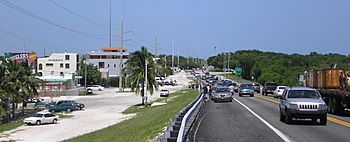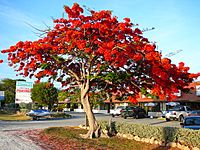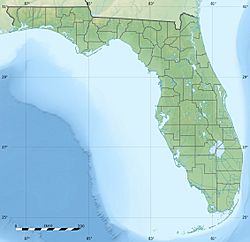Plantation Key facts for kids

Plantation Key, as seen from the Snake Creek drawbridge looking north.
|
|
| Geography | |
|---|---|
| Location | Gulf of Mexico |
| Coordinates | 24°59′04″N 80°33′40″W / 24.9844°N 80.5611°W |
| Archipelago | Florida Keys |
| Adjacent bodies of water | Florida Straits |
| Administration | |
| State | Florida |
| County | Monroe |
Plantation Key is an island located in Monroe County, Florida, United States. It's part of the beautiful Florida Keys. You can find it along U.S. 1, also known as the Overseas Highway. It sits between Key Largo and Windley Key. Since November 4, 1997, the entire island has been part of the Village of Islamorada.
Where is Plantation Key?
Plantation Key is located at coordinates 24°58′33″N 80°33′08″W. It has natural borders that separate it from other keys. To its northeast, Tavernier Creek (around Mile Marker 91.0 on the Overseas Highway) separates it from Key Largo. To its southwest, Snake Creek (around Mile Marker 85.5) separates it from Windley Key.
A Look Back in Time

People have lived on Plantation Key for a very long time. Native Americans called this island home at least 1,000 years before Europeans arrived. There used to be a large mound on the island. Old items found there show people lived here between 500 and 700 A.D. Sadly, this mound was removed in 1958 to make way for new buildings.
In the mid-1800s, families from Bahamas started to settle on Plantation Key. By the 1870s and 1880s, more families had moved to the island. They grew crops like coconuts and pineapples. These crops were then shipped by large sailing boats called schooners to cities like Baltimore and New York City in the northern U.S.
When the Overseas Railroad was finished, it changed life on the island. The railway brought pineapples from Cuba at very low prices. This made it hard for local growers to sell their own pineapples.
Before the railway was built, a small waterway called Little Snake Creek divided the southwest end of Plantation Key. This made that part a separate island known as Snake Creek Key. Many old Native American sites were on Plantation Key, but most have been changed by new buildings. An early settlement on the ocean side was called Pearl City. It got its name from a large conch pearl found there by a man named John Lowe.
Images for kids




